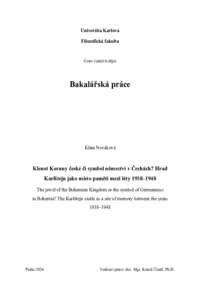Klenot Koruny české či symbol němectví v Čechách? Hrad Karlštejn jako místo paměti mezi léty 1938-1948
The jewel of the Bohemian Kingdom or the symbol of Germanness in Bohemia? The Karlštejn castle as a site of memory between the years 1938-48
bachelor thesis (DEFENDED)

View/
Permanent link
http://hdl.handle.net/20.500.11956/192250Identifiers
Study Information System: 267737
Collections
- Kvalifikační práce [23745]
Author
Advisor
Referee
Randák, Jan
Faculty / Institute
Faculty of Arts
Discipline
History
Department
Institute of Czech History
Date of defense
14. 6. 2024
Publisher
Univerzita Karlova, Filozofická fakultaLanguage
Czech
Grade
Excellent
Keywords (Czech)
Karlštejn|místo paměti|pamětní kniha|kulturní paměť|Karel IV.|kulturní dědictví|památková edukaceKeywords (English)
Karlštejn|site of memory|visitors book|cultural memory|cultural heritage|heritage educationBakalářská práce se zabývá hradem Karlštejnem jako místem paměti. Zkoumá, jak byl prezentován a vnímán veřejností mezi léty 1938-48. Metodologicky práce vychází z paměťových studií a využívá především koncept míst paměti formulovaný Pierrem Norou. V českém prostředí představuje klíčovou inspiraci práce Davida Venclíka zaměřená na Karlštejn jako místo paměti ve starším období. Primárním pramenem jsou pamětní knihy hradu Karlštejn, údaje o návštěvnosti a další rozličné propagační materiály. Práce se zaměřuje především na kvalitativní analýzu pamětních knih. Ve spojení s dalšími zmíněnými materiály je cílem autorky představit pohled veřejnosti na hrad Karlštejn v letech 1938-1948. Autorka též představí možnosti dalšího využití pamětních knih v oblasti paměťových studií. V závěru práce nabídne komparaci proměny vnímání hradu ve sledovaném období s předválečnou dobou a s obdobím po roce 1948 až do současnosti.
The bachelor thesis deals with Karlštejn Castle as a site of memory. It examines how it was presented and perceived by the public between the years 1938-48. Methodologically, the thesis is based on memory studies and mainly uses the concept of sites of memory formulated by Pierre Nora. The work of David Venclík focusing on Karlštejn as a place of memory in the earlier period is a key inspiration in the Czech environment for this thesis. The primary sources are the visitors' books of Karlštejn Castle, visitor data, and other various promotional materials. The work focuses mainly on the qualitative analysis of the memory books. In conjunction with the other materials mentioned, the author aims to present the public's view of Karlštejn Castle between 1938 and 1948. The author will also present the possibilities of further use of commemorative books in the field of memory studies. At the end of the thesis, she will offer a comparison of the changing perception of the castle in the pre-war period and the period after 1948 until the present day.
